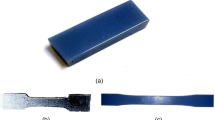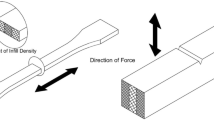Abstract
3D printing in additive manufacturing is considered as one of key technologies to the future high-precision manufacturing in order to benefit diverse industries in building construction, product development, biomedical innovation, etc. The increasing applications of 3D printed components depend primarily on their significant merits of reduced weight, minimum used materials, high precision and shorter production time. Furthermore, it is very crucial that such 3D printed components can maintain the same or even better material performance and product quality as those achieved by conventional manufacturing methods. This study successfully fabricated 3D printed mechanical testing samples of PLA and PLA/wood fibre composites. 3D printing parameters including infill density, layer height and the number of shells were investigated via design of experiments (DoE), among which the number of shells was determined as the most significant factor for maximising tensile strengths of PLA samples. Further, DoE work evaluated the effect of material type (i.e., neat PLA and PLA/wood fibres) and the number of shells on tensile, flexural and impact strengths of material samples. It is suggested that material type is the only predominant factor for maximising all mechanical strengths, which however are consistently lower for PLA/wood fibre composites when compared with those of neat PLA. Increasing the number of shells, on the other hand, has been found to improve almost all strength levels and decrease infill cavities.








Similar content being viewed by others
References
Chen D, Heyer S, Ibbotson S et al (2015) Direct digital manufacturing: definition, evolution, and sustainability implications. J Clean Prod 107:615–625
Murphy SV, Atala A (2014) 3D bioprinting of tissues and organs. Nat Biotechnol 32:773–785
Gao W, Zhang Y, Ramanujan D et al (2015) The status, challenges, and future of additive manufacturing in engineering. Comput-Aided Des 69:65–89
Li X, Cui R, Sun L et al (2014) 3D-printed biopolymers for tissue engineering application. Int J Polym Sci 24:1–13
Patricio T, Domingos M, Gloria A et al (2013) Characterisation of PCL and PCL/PLA scaffolds for tissue engineering. Procedia CIRP 5:110–114
Senatov FS, Niaza KV, Zadorozhnyy MY et al (2016) Mechanical properties and shape memory effect of 3D-printed PLA-based Porous scaffolds. J Mech Behav Biomed Mater 57:139–148
Rosenzweig DH, Carelli E, Steffen T et al (2015) 3D-printed ABS and PLA scaffolds for cartilage and mucleus pulposus tissue regeneration. Int J Mol Sci 16:15118–15135
Inzana JA, Olvera D, Fuller SM et al (2014) 3D printing of composite calcium phosphate and collagen scaffolds for bone regeneration. Biomaterials 35:4026–4034
Bakarich SE, Gorkin IR, Panhuis MIH et al (2014) Three-dimensional printing fiber reinforced hydrogel composites. ACS Appl Mater Interfaces 6:15998–16006
Le Duigou A, Castro M, Bevan R et al (2016) 3D printing of wood fibre biocomposites: from mechanical to actuation functionality. Mater Des 96:106–114
Suwanprateeb J, Sanngam R, Suvannapruk W et al (2009) Mechanical and in vitro performance of apatite-wollastonite glass ceramic reinforced hydroxyapatite composite fabricated by 3D-printing. J Mater Sci-Mater Med 20:1281–1289
Compton BG, Lewis JA (2014) 3D-printing of lightweight cellular composites. Adv Mater 26:5930–5935
Richter C, Lipson H (2011) Untethered hovering flapping flight of a 3D-printed mechanical insect. Artif Life 17:73–86
Park SH (1996) Robust design and analysis for quality engineering. Chapman & Hall, London
Dong Y, Bhattacharyya D (2008) Effect of clay type, clay/compatibiliser content and matrix viscosity on the mechanical properties of polypropylene/organoclay nanocomposites. Compos Part A Appl Sci Manuf 39:1177–1191
Dong Y, Bickford T, Haroosh HJ et al (2013) Multi-response analysis in the material characterisation of electrospun poly (lactic acid)/halloysite nanotube composite fibres based on Taguchi design of experiments: fibre diameter, non-intercalation and nucleation effects. Appl Phys A Mater Sci Process 112:747–757
Author information
Authors and Affiliations
Corresponding author
Rights and permissions
About this article
Cite this article
Dong, Y., Milentis, J. & Pramanik, A. Additive manufacturing of mechanical testing samples based on virgin poly (lactic acid) (PLA) and PLA/wood fibre composites. Adv. Manuf. 6, 71–82 (2018). https://doi.org/10.1007/s40436-018-0211-3
Received:
Accepted:
Published:
Issue Date:
DOI: https://doi.org/10.1007/s40436-018-0211-3




